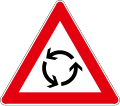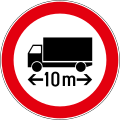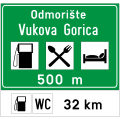Road signs in Croatia

Road signs in Croatia are regulated in Pravilnik o prometnim znakovima signalizaciji i opremi na cestama.[1] The shape and design of the road signs largely follow the road signs used in most European countries, including European Union countries (France, Germany, Italy etc.), to which Croatia joined in 2013. A similar design of road signs is used in the neighboring countries of the former Yugoslavia like Slovenia, Bosnia and Herzegovina, and also North Macedonia (the latter two are not members of the EU).
The former Yugoslavia had originally signed the Vienna Convention on Road Signs and Signals on November 8, 1968, and ratified it on June 6, 1977.[2] Yugoslavia formerly used a yellow background on warning signs. After the breakup of Yugoslavia when Croatia declared its independence in 1991, the country succeeded to the Vienna Convention on November 2, 1993.
Croatian signs use the Hrvatsko cestovno pismo (lit. 'Croatian road font') for the text on their signs.[3]
Warning signs
[edit]Warning signs (Croatian: Znakovi opasnosti) indicate to road users the proximity of a part of the road or a place where road users are at risk.[4][5]
-
A01
Danger ahead -
A02
An intersection -
A03
A roundabout -
A04
Intersection with non-priority road -
A04-1
Non-priority road ahead -
A04-2
Non-priority road ahead -
A04-3
Non-priority road ahead -
A04-4
Non-priority road ahead -
A05
A curve to the left -
A05-1
A curve to the right -
A05-2
Double curve -
A05-3
Double curve -
A06
Dangerous descent -
A07
Dangerous climb -
A08
Carriageway narrows -
A08-1
Narrowing of the road on the right -
A08-2
Narrowing of the road on the left -
A09
Warning for bump -
A09-1
Dip -
A09-2
Uneven road -
A09-3
Ruts -
A10
Skidding danger -
A11
Ice on road -
A12
Pebbles on the road -
A13
Danger of rocks falling of a cliff -
A14
Traffic light incoming -
A14-1
Traffic light incoming -
A15
Road works -
A16
Traffic in both directions -
A17
Traffic accident -
A18
A queue of cars -
A19
Danger of falling onto unpaved area -
A20
Pedestrians on the road -
A21
Pedestarian crossing -
A22
Possibility of children on the road -
A22-1
Children -
A22-2
Children -
A23
Airport runway nearby -
A24
A tunnel -
A25
Danger of side wind -
A26
Fire hazard -
A27
Cyclists -
A28
Rising bridge -
A29
Coast nearby -
A30
Tractor -
A31
Tram tracks -
A32
Animals for cattle -
A33
Animals for deer -
A34
Crossing over the rail with a ramp or protection -
A35
Crossing over the rail without protection -
A36
Distance to the road-railway crossing -
A36-1
Distance to the road-railway crossing -
A36-2
240 meters until railroad crossing -
A36-3
160 meters until railroad crossing -
A36-4
80 meters until railroad crossing -
A36-5
Distance to the road-railway crossing -
A36-6
Distance to the road-railway crossing -
A36-7
240 meters until railroad crossing -
A36-8
160 meters until railroad crossing -
A36-9
80 meters until railroad crossing -
A37
Railway crossing (Andrew's cross) -
A37-1
Railway crossing -
A38
Encountering a vehicle moving in the opposite direction on a multi-lane road -
A39
Crossing over the railway line on a side road -
A39-1
Crossing over the railway line on a side road
Order signs
[edit]Order signs (Croatian: Znakovi izričitih naredbi) inform road users of prohibitions, restrictions and obligations.[6][7] This category includes priority signs "Stop sign", "Give Way", "Yield to oncoming traffic", prohibitory and mandatory signs.
-
B01
Give way -
B02
Stop sign -
B03
No motor vehicles access -
B04
Do not enter -
B05
Give way to oncoming traffic -
B06
No entry for motor vehicles expect for motorcycles without needing a trailer -
B07
No entry for buses -
B08
No entry for trucks -
B09
No entry for vehicles with dangerous goods, which may cause water pollution -
B10
No entry for vehicles with explosive or flammable goods -
B11
No entry for vehicles with dangerous goods -
B12
No entry for vehicles with connected trailers -
B13
No entry for vehicles with connected semi-trailers -
B14
No entry for tractors -
B15
No entry for motorcycles -
B16
No entry for mopeds and bicycles -
B17
No entry for bicycles -
B18
No entry for horse drawned vehicles -
B20
No entry for motor vehicles -
B21
No entry for pedestrians -
B22
Width limit -
B23
Height limit -
B24
Weight limit -
B25
Weight per axle limit -
B26
Length limit -
B27
Minimum distance between vehicles -
B28
No left turn -
B28-1
No right turn -
B29
No U-turn -
B30
Speed limit (30 km/h) -
B30
Speed limit (50 km/h) -
B31
Overtaking prohibited -
B32
Overtaking prohibited for trucks -
B33
Customs -
B33-1
Toll road -
B33-2
Police -
B34
No warning signal devices (klaksons) -
B35
No camera devices -
B36
No stopping or parking -
B37
No parking -
B38
Minimum speed limit (40 km/h) -
B39
Winter chains -
B40
Bicycle path -
B41
Pedestrian path -
B42
Bicycle path combined with pedestrian path -
B42
Bicycle path combined with pedestrian path -
B43
Bicycle and pedestrian path -
B44
Animal riding path -
B45
Go straight -
B45-1
Turn right -
B45-2
Turn left -
B45-3
Turn left -
B45-4
Turn right -
B45-5
U-turn permitted -
B45-6
Roundabout -
B46
Go straight or turn left -
B46-1
Go straight or turn right -
B46-2
Turn left or right -
B47
Keep right -
B47-1
Keep left -
B47-2
Keep on both sides -
B48
Turn on lights
Information signs
[edit]Information signs (Croatian: Znakovi obavijesti) provide road users with the necessary information about the road they are on, the names of the places through which the road passes and the distances to those places, the termination of validity of explicit command signs, and other information that can be useful to them.[8][9] This category includes priority signs "Priority over oncoming traffic" "Priority road" and "End of priority road".
-
C01
Priority over oncoming traffic -
C02-1
Bicycle crossing -
C03
Children -
C04
Pedestrian underpass or overpass -
C05
One way road -
C05-1
One way road on the side -
C05-2
One way road on the side -
C06
Priority road -
C07
End of priority road -
C08
Speed bump -
C09
End of overtaking -
C10
End of overtaking trucks -
C11
End of maximum speed limit -
C12
End of minimum speed limit -
C13
End of prohibiting warning signal devices -
C14
End of restrictions -
C15
End of winter chains -
C16
End of bicycle path -
C17
End of pedestrian path -
C18
End of bicycle path combined with pedestrian path -
C18
End of bicycle path combined with pedestrian path -
C19
End of bicycle and pedestrian path -
C20
End of animal riding path -
C21
Turn off lights (End of turning on lights) -
C22
Speed limit zone -
C23
End of speed limit zone -
C24
No parking zone -
C25
End of no parking zone -
C26
Pedestrian zone -
C27
End of pedestrian zone -
C28
Residential zone -
C29
End of residential zone -
C30
Greenway pedestrian and bicycle path -
C31
Blind pedestrians -
C32
End of blind pedestrians -
C33
Recommended speed -
C34
End of recommended speed -
C35
School patrol -
C36
Hospital -
C37
First aid -
C38
Police station -
C39
Parking -
C39-1
Covered parking -
C39-2
Parking only with parking meter (automat) -
C41
Phone booth -
C41-1
Emergency phone -
C42
Gas station -
C42-1
LPG gas station -
C42-2
CNG gas station -
C42-3
Charging station for electric cars -
C43
Information -
C44
Hotel or motel -
C45
Restaurant -
C46
Drinkable water -
C47
Bus or trolleybus stop -
C48
Tram stop -
C49
Taxi stop -
C50
Airport -
C51
Water port -
C51-1
Ferry -
C52
Sailing yacht -
C53
Café -
C54
Camping -
C54-1
Camping for residential trailers -
C54-2
Camping for campervans -
C54-3
Parking for constitute water pollution device of campervans -
C55
Rest stop -
C56
Youth hostel -
C57
Fire extinguisher -
C58
Highway maintenance -
C59
Repairment of technical maintenance of vehicles -
C59-1
Tire shop -
C60
WC -
C61
Carwash -
C62
Traffic radio station -
C63
Water protection area -
C64
Highway -
C65
End of highway -
C66
Road for motor vehicles -
C67
End of road for motor vehicles -
C68
Dead end -
C69
Traffic section where the left turn is prohibited -
C70
Emergency lane -
C70-1
Emergency lane (emergency phone) -
C71
Mountain pass -
C72
River name -
C73
Road structure (tunnel) -
C74
Road structure (bridge) -
C75
Wildlife crossing -
C76
Settlement -
C77
End of settlement -
C78
Directional sign -
C78-1
Directional sign -
C80
Directional sign for an airport -
C81
Directional sign for a highway or road for motor vehicles -
C81-1
Directional sign for a highway or road for motor vehicles -
C83
Lane change -
C83-1
Lane change with settlement directions -
C83-2
Cycle rearranging -
C84
Public transport lane begins -
C85
Public transport lane ends -
C86
Public transport lane -
C87
New lane -
C88
Lane ends -
C89
Slow vehicles lane -
C90
End of slow vehicles lane -
C92
Exit signpost -
C93
Rest stop -
C93-1
Rest stop -
C95
Prohibition of certain types of vehicles on a highway or an expressway -
C96
Toll -
C97
Reminder of the toll -
C98
Realignment of vehicles in front of the toll collection facility -
C99
Mandatory taking of a toll ticket -
C99-1
Toll booth -
C99-2
Electronic toll payment -
C99-4
Smart card toll payment -
C105
Traffic controlled by a road official -
C108
Lane for certain vehicles -
C108-1
Lane for certain vehicles -
C109
Maximum speed limits on each road -
C110
Highway intersection number -
C111
International road number (European route) -
C112
Highway number -
C113
State road number -
C113-1
County road number -
C114
Kilometer sign for highways and expressways -
C115
Marking of a state road section -
C115-1
Marking of a county road section -
C119
STOP! Wrong way -
C120
Emergency exit -
C121
Directions towards emergency exist -
C122
Speed control -
C123
Traffic control -
C124
National car sticker/Oval car sticker (for car country identification abroad) -
C125
Republic of Croatia -
C126
Mandatory direction for certain vehicles -
C127-2
Mandatory direction for certain vehicles -
C128
Intervention passage -
C129-1
Notice board about the origin of the passengers (All passports)
Information and direction signs
[edit]Information and direction signs (Croatian: Znakovi obavijesti za vođenje prometa) inform road users about the provision of road directions, the layout of destinations and the management of traffic towards them, intersections and junctions on a certain road direction and distances to destinations.[10][11]
-
D01
Exit from a highway or an expressway -
D02
Highway intersection -
D03
An intersection -
D03-1
An intersection -
D03-2
An intersection of circular shape -
D04
Pre-signpost billboard -
D05
Preliminary direction indicator -
D06
Preliminary direction indicator for exit -
D06-1
Preliminary direction indicator for exit -
D07
Preliminary direction indicator -
D08
Preliminary direction indicator at a portal over one lane -
D08-1
Preliminary direction indicator at a portal over one lane -
D09
Confirmation of the direction
Additional signs
[edit]Additional signs (Croatian: Dopunske ploče) are used in addition to warning, order and information signs. Additional signs specify the meaning of the traffic sign in more detail.[12][13]
-
E01
Distance -
E02
Distance -
E02-1
Distance to STOP -
E05
Except for tenants -
E06
Vehicle categories -
E06-1
Vehicle categories -
E06-3
Vehicle categories -
E06-4
Vehicle categories -
E06-5
Vehicle categories -
E06-6
Vehicle categories -
E06-7
Vehicle categories -
E08
Tow away -
E09
Additional distance -
E09-1
Additional distance -
E09-2
Additional distance -
E09-3
Beginning of parking or stopping ban -
E09-4
Continuation of parking or stopping ban -
E09-5
Ending of parking or stopping ban -
E10
Parking position -
E10-2
Parking position -
E10-3
Parking position -
E26
Parking position -
E10-5
Parking position -
E10-6
Parking position -
E10-7
Parking position -
E10-8
Parking position -
E11
Disabled -
E12
Reserved for Croatian Army vehicles -
E13
Rain -
E13-1
Ice or snow -
E14
Priority road direction (with Priority road) -
E15
Disabled pedestrian -
E15-1
Blind people -
E16
Snow plows in action -
E17
Signage under renovation -
E18
Rough road for ... kilometres -
E19
Speed bump -
E21
Road closed due to smog -
E22
Area susceptible to closures due to smog
Retired signs
[edit]-
E41
Accident (2005) -
E42
Amphibians (2005) -
E45
Refueling with LPG (2005) -
E46
Exit from motorways (2005) -
E47
Junction (2005)
See also
[edit]References
[edit]- ^ "Pravilnik o prometnim znakovima, signalizaciji i opremi na cestama". narodne-novine.nn.hr (in Croatian). Retrieved 2023-02-28.
- ^ "United Nations Treaty Collection". treaties.un.org. Retrieved 2023-12-08.
- ^ "Pravilnik o prometnim znakovima, signalizaciji i opremi na cestama". narodne-novine.nn.hr. Retrieved 2024-11-11.
- ^ "A - Znakovi opasnosti | Vepel d.o.o." (in Croatian). Retrieved 2023-09-01.
- ^ "A". narodne-novine.nn.hr. Retrieved 2023-09-01.
- ^ "B - Znakovi izričitih naredbi | Vepel d.o.o." (in Croatian). Retrieved 2023-09-01.
- ^ "B". narodne-novine.nn.hr (in Croatian). Retrieved 2023-09-01.
- ^ "C - Znakovi obavijesti | Vepel d.o.o." (in Croatian). Retrieved 2023-09-01.
- ^ "C". narodne-novine.nn.hr. Retrieved 2023-09-01.
- ^ "D - Znakovi obavijesti za vođenje prometa | Vepel d.o.o." (in Croatian). Retrieved 2023-09-01.
- ^ "D". narodne-novine.nn.hr (in Croatian). Retrieved 2023-09-01.
- ^ "E - Dopunske ploče | Vepel d.o.o." (in Croatian). Retrieved 2023-09-01.
- ^ "E". narodne-novine.nn.hr (in Croatian). Retrieved 2023-09-01.
External links
[edit]- Zakon o sigurnosti prometa na cestama od 20. kolovoza 2004.
- Pravilnik o prometnim znakovima, opremi i signalizaciji na cestama od 14. ožujka 2005. (N.N. 33/05)
- Internet portal specijaliziran za prometnu signalizaciju i opremu ceste
- Prometna signalizacija Hrvatska tehnička enciklopedija, portal hrvatske tehničke baštine. LZMK
- [1]




















































































































































































































































































































